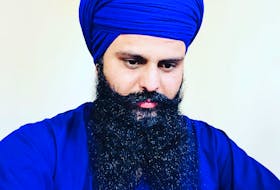EDITOR’S NOTE: This is part of a series profiling abandoned and derelict vessels across the South Shore.
Framed by fluttering flags, South Shore - St. Margarets MP Bernadette Jordan announced that the Canadian Coast Guard is starting to assess the abandoned HMCS Cormorant.
Jordan made the announcement at the Municipal Park in Bridgewater and added it marked the first steps towards finally removing the decommissioned Royal Canadian Navy ship.
“I’ve been working on this for a number of years, as you know,” said Jordan to the gathered crowd of local and provincial media.
“We’ve had great success in getting the bills passed we needed in order to address this problem. This is not a problem just in this area, this is a problem in many coastal communities.”
Despite the coming assessment, the reality is that the rusted Cormorant will continue to sit for a while longer, lining the banks of the LaHave River as it has for years.
Like many issues concerning abandoned and derelict vessels in Canada, the questions are many and the answers few.
Dave Yard, the Canadian Coast Guard’s superintendent for environmental response in the Atlantic region, was able to confirm the impending assessment would check for pollutants, air quality issues and hull integrity.
However, when asked for a definitive timeline or price tag, neither Yard or Jordan had an answer.
“All I can say is we’re going to do a technical assessment to determine what risk the vessel poses to the marine environment and to quantify if there are any pollutants on board,” responded Yard.
Jordan noted the next steps, and therefore the cost, will depend on what’s identified by the assessment.
For his part, Bridgewater Mayor David Mitchell said he was excited for any progress on an issue which has plagued the town for years.
“Any announcement to begin any type of process is a good day for Bridgewater,” he said, adding that the ships pose safety and environmental concerns.
But the Cormorant is just one of several abandoned and derelict vessels lining the Port of Bridgewater; three other vessels are also tied up to the port.
“This has the potential to solve one problem,” said Mitchell of the announcement. “There’s three more behind it that have to be solved as well.”
And like dozens of other vessels littered across the South Shore, they’ll likely stay put until authorities identify and prioritize vessels to be removed.
CHANGING THE LAW
Following the announcement, Jordan sat down for an exclusive interview with the South Shore Breaker back at her constituency office.
She said abandoned and derelict vessels are an issue she’s championed since being voted into Parliament in 2015.
“When I first started looking into this, I initially thought it was just a South Shore issue,” she said, adding she realized the scale of the problem once she introduced motion M-40, the motion to remove abandoned and derelict vessels.
“I realized this is a national problem.”
As per previous Transport Canada numbers, some 600 derelict vessels are estimated to be polluting Canadian waterways.
A spokesperson for the federal Department of Oceans and Fisheries was unable to provide a figure for either Nova Scotia or the South Shore.
But until recently, there was no law to stop owners from abandoning their vessels.
“Up until now, it’s never been illegal,” said Jordan. “Unless it was blocking navigable water or unless it was an environmental concern, you could just leave it.”
Jordan said the recently minted Wrecked, Abandoned, or Hazardous Vessels Act — which was passed in February of this year — will strengthen owner liability.
The act also makes it illegal to abandon, sink, ground or leave a vessel adrift.
In terms of enforcement, the act features an expanded ship’s registry and forces larger vessels to purchase liability insurance.
The problem now, said Jordan, is addressing ships that are already abandoned like in Bridgewater.
“We always try to identify who is responsible,” she said, although sometimes it’s not possible to identify the owners.
But removing abandoned vessels is not simply a matter of hauling them out of the water.
“It’s such a technical issue,” said Jordan, explaining that attempts first need to be made to identify owners and to assess safety hazards.
There’s also a level of prioritization when it comes to removal.
Jordan noted ships are assessed and listed based on potential threats to the environment; the Farley Mowat, for example, was a priority for removal in Shelburne because it was an “environmental accident” waiting to happen.
Overall, Jordan acknowledged that some people may be frustrated but said the current federal government was the first to enact legislation to protect Canada’s waterways, something especially relevant in the country’s ocean playground.
“It’s a step in the right direction,” she said.
The series will continue next week and will examine the environmental and financial impacts of abandoned and derelict vessels across the South Shore.









